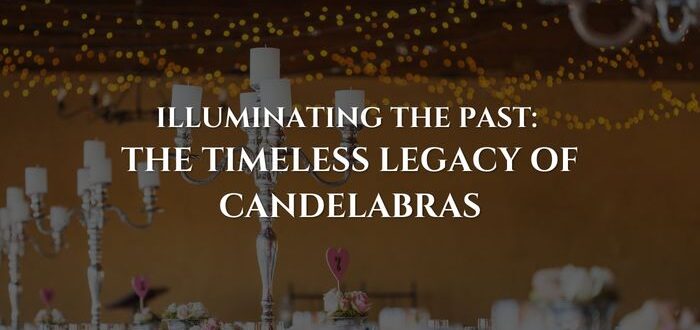The Legacy of Candelabras
andelabras are timeless symbols of elegance and grandeur, lighting up the tables and halls of castles, mansions, and churches for centuries. From ancient rituals to modern decor, the candelabra has journeyed through the ages, adapting to the tastes and needs of different eras. In this article, we’ll explore the history, evolution, and styles of candelabras, and provide a guide to caring for these treasured pieces.

The Origins and History of the Candelabra
The term “candelabra,” originating from the Latin word “candelabrum,” refers to a decorative, branched holder designed to support multiple candles. Traditionally used as a focal point on tables or strategically placed around rooms, candelabras have been integral to interior design for centuries.
The origins of the candelabra date back to ancient civilizations, where simple branched candle holders were used to light homes and temples. Over time, as design and craftsmanship evolved, candelabras took on a dual role as both functional and ornamental objects. No longer just sources of light, they became symbols of wealth and status, gracing the halls and estates of the nobility and royal families.
In modern times, candelabras remain a favoured choice for both lighting and decoration. Whether they illuminate a grand dining hall or add a warm glow to a cozy living room, candelabras infuse spaces with elegance and a sense of timeless ambiance.
Evolution of Candelabras
- Medieval and Gothic Candelabras
During the medieval period, candelabras were primarily found in churches and castles. Gothic candelabras were typically tall and heavy, often made from wrought iron and featuring dramatic, pointed designs inspired by the architecture of the time.
- Baroque and Rococo Candelabras
The Baroque and Rococo periods saw a rise in the popularity of elaborate, decorative candelabras. Baroque candelabras, were often made from gilded brass or bronze and featured intricate designs. In contrast, Rococo candelabras from the 18th century were lighter, featuring playful elements such as cherubs and intricate foliage.
- Neoclassical Candelabras
The Neoclassical movement brought a return to simpler, symmetrical designs influenced by ancient Greek and Roman art. Candelabras from this period are characterized by clean lines, urn shapes, and motifs like laurel wreaths.
- Victorian and Edwardian Candelabras
Victorian candelabras, featuring elaborate engravings, often showcased a mix of styles, with influences from Gothic, Renaissance, and Classical design elements. This eclectic style was popular in the homes of the wealthy during the 19th century. In the Edwardian era, designs became more refined and lighter, moving away from the heavier and ornate Victorian style.
- Art Deco Candelabras
The Art Deco movement in the early 20th century introduced bold, geometric designs. Art Deco candelabras often featured straight lines, symmetrical patterns, and stylized motifs that reflected the modern spirit of the age.

Types of Candelabras
Candelabras come in a variety of shapes and sizes, each suited to different settings and styles. They can generally be divided into several main types:
- Tabletop Candelabras: Designed to sit on tables, these candelabras are often used as striking centerpieces at formal gatherings. They come in various sizes, from smaller designs ideal for intimate dinners to larger, more dramatic pieces perfect for grand banquets.
- Hanging Candelabras: Suspended from the ceiling, hanging candelabras provide an elegant way to light up large spaces, such as banquet halls and event venues. Popular styles include Gothic, Art Deco, and classic chandelier-inspired designs, which can add both ambiance and sophistication to any room.
- Wall-Mounted Candelabras: Attached directly to the wall, these candelabras enhance a variety of interior styles, from vintage and traditional to modern. Wall-mounted candelabras are a beautiful way to add a touch of elegance and ambient lighting to living rooms, hallways, and dining areas.
- Single-Arm Candelabras: These minimalist candelabras have a single arm, making them ideal for smaller spaces or as subtle accents on tables or mantels. Their compact size allows them to fit easily into cozy settings.
- Multi-Arm Candelabras: These are larger candelabras with multiple arms—usually between two and seven—that hold several candles, creating a brighter and more impressive display. Multi-arm candelabras are well-suited for areas that require additional lighting or a bolder visual statement.

Materials and Design
Candelabras are crafted from a wide range of materials. Here are some of the most commonly used:
- Metal: Metals like brass, bronze, silver, and gold are popular choices due to their durability, polished finish, and easy maintenance. Metal candelabras can be moulded into elaborate shapes or engraved with intricate details, making them ideal for both modern and classic designs.
- Glass: Known for their delicate elegance, glass candelabras offer a transparent shine and are often crafted in detailed, artistic forms, sometimes featuring vibrant colours. While they add a touch of sophistication, they do require careful handling.
- Ceramic: Candelabras made from ceramic bring a rustic and earthy charm to any setting. These pieces are often hand-painted, showcasing unique patterns and bold colours.
- Wood: Wooden candelabras have a warm, natural appeal and can be either intricately carved or left with a simpler finish to highlight the wood’s natural grain. This material is ideal for adding an organic, timeless feel to both traditional and contemporary spaces.

Caring for Candelabras
Candelabras, especially vintage ones, require proper care to maintain their beauty and longevity. Here are some tips to ensure your candelabras remain in excellent condition:
- Regular Dusting: Dusting with a soft, lint-free cloth prevents buildup that can dull the surface. Avoid using abrasive materials, which can scratch the metal.
- Cleaning Silver Candelabras: Use a silver polishing cloth to maintain the shine. For tarnished areas, apply a gentle silver polish, following the manufacturer’s instructions carefully.
- Avoid Water Damage: Never submerge antique candelabras in water, as moisture can corrode certain metals over time. If necessary, use a damp cloth and dry immediately.
- Handle with Care: Many historic candelabras have delicate arms or embellishments. Always handle them with care to avoid bending or breaking any parts.
Giftex’s 7th Edition: A Showcase of Vintage Lightings
Get ready to illuminate your home with timeless beauty as Giftex’s 7th Edition “A World of Collectibles” Auction showcases an exquisite collection of vintage lighting on December 16–17. From stunning chandeliers to elegant candelabras, this auction features everything you need to bring warm, radiant light and historical charm into your living space.
Featured Candelabra: A Showstopper in the Auction
Among the most talked-about pieces is a stunning vintage French Candelabra, capturing attention for its intricate design and timeless appeal. This candelabra combines historical craftsmanship with sophisticated style, making it a captivating addition to any home. Don’t miss the chance to bring this remarkable piece of vintage lighting into your collection.

[ Bid & bring home vibrant creativity
Add a touch of elegance to your home or any social event with exquisite candelabras!
Giftex is set to bring this vintage candelabra for auction. With this piece, you can add visual interest to a room.
Bring your dream decor to life with our stunning collection of vintage furniture and home decor collectibles!






